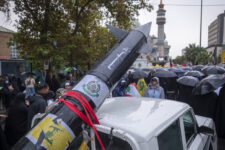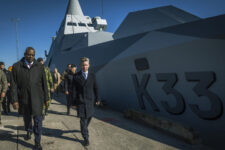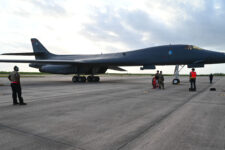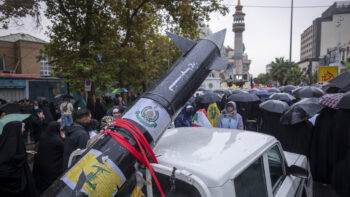
U.S. Army Reserve soldiers receive an overview of Washington D.C. as part of the 4th Annual Day with the Army Reserve May 25, 2016. The event was led by the Private Public Partnership office. (U.S. Army photo by Sgt. 1st Class Marisol Walker)
While Capitol Hill’s eyes are on the fiscal 2025 defense budget, the Pentagon is at work thinking about, planning, and formulating the fiscal 2026 edition. It will work in earnest over the coming weeks to transition FY26 program, which will resource the force between FY26-FY30, from development to the “build” phase to review by the Office of the Secretary of Defense.
As Pentagon leadership parses through each service’s changes to their defense plans, it’s essential that they craft a defense program fit to reality. This would be one that accounts for the world we find ourselves in, with two ongoing ground wars requiring American support, a more aggressive China and a more assertive North Korea. And while there may be a new administration come January, there is little time to make major changes to what is being crafted now.
So, where should Pentagon leaders begin? By making this the budget of “pivots,” moving away from systems that simply don’t make sense for the department’s future. Focus on three areas: unmanned aerial and sea vehicles, munitions, and people. The military should at the same time move away from manned aircraft, steer clear of a reorganization of our nuclear forces, and engage in an aggressive divestment of bloated and expensive new programs.
To start with, the FY26 budget should fully fund the House’s 19.5 percent pay raise for our junior enlisted service members. The administration has notably rejected this proposal and it remains to be seen what will emerge from conference negotiations come the fall. Our service members are first and foremost our most important asset and beginning in 2027, the dearth of 18-year-olds will reduce recruiting. 2026 is the last year to get out in front of this ticking demographic time bomb.
Next, the Navy. The National Commission on the Future of the Navy has now been fully appointed, albeit nearly two years late. The Navy should begin leaning forward into utilizing this commission by creating the fiscal headroom to rapidly implement its recommendations. One way to do this is for the Navy to terminate its future F-35 purchases as well as look at potentially cancelling the manned sixth-generation fighter, setting the future course for Naval Aviation on a path to being largely unmanned. Doing this will also allow the Navy to put its newfound savings into a separate fund that will jumpstart an aggressive move into unmanned sea vehicles. Unlike aviation, whose future lies in largely unmanned vehicles, the Navy is likely to need a mix of manned and unmanned vessels. The fight in the Black Sea should be a guide for starting this transition.
Third, the Air Force. The service’s senior leadership recently shot up a flare for help in its talk about potentially changing its procurement strategy for the Next Generation Air Dominance (NGAD). NGAD isn’t the Air Force’s problem, but is rather a symptom: The service’s real problem lies in the mushrooming costs of the F-35 and nuclear modernization. Consequently, the Air Force should terminate rest of its planned F-35 buy. Even more dramatically, the service should spin off, similar to the Space Force, a separate service for the air and ground nuclear forces. The nuclear mission is a national requirement, and it can never get the same attention it needs when competing with jets and drones.
RELATED: As Air Force deliberates sixth-gen fighter plans, much is at stake for Boeing
Finally, the Army. The Army was on the right track at the tail end of the last decade, divesting many of its failed acquisition programs and instead focusing on building up its forces for war in this decade. Sadly, it took a detour into the 2030s at the expense of the 2020s. The time has come to pivot back. The Army should cancel its Optionally Manned Fighting Vehicle and Future Vertical Lift. These funds should be reinvested into bullets, tanks, and counter-UAV systems. The Army should learn lessons from Ukraine, where weaponizing commercial items is proving to be more effective in war than trying to develop purely unique defense items. The Army needs to relearn fighting at scale, and that means scaling back on niche weapons. Of course, the Pentagon does not control its budget topline, which is set by the White House. However, it should be obvious that defense spending needs to increase. Start by reading and adopting the topline increase proposed by Sen. Roger Wicker in his 21st Century Peace Through Strength plan. He calls for $55 billion to be added to the defense budget, and more thereafter, until spending reaches 5 percent of GDP.
While many will debate what level of GDP is appropriate, the $55 billion increase for FY26 is a great starting point. For the above suggestions, setting aside $10 billion of that $55 billion for the Navy makes sense, while the Air Force should use some of that money to plot out its future, which could include NGAD and tens of thousands of unmanned aircraft.
RELATED: 5% GDP: Top SASC Republican pitches dramatic jump in defense spending, $55B more in FY25
With the world on the brink of war, it is time to discard the deluded assumptions that we are living in a decade of peace and that we can shoulder risks today to protect ourselves in the future. That strategic theory emboldened our adversaries to act this decade. Given our anemic industrial base, war is now a truly come-as-you-are enterprise, with the winner possibly being the side that can fight the longest. Therefore, we need to invest in capability and capacity today.
Pentagon leadership should be professionally embarrassed that Sen. Wicker has a more coherent plan than they do. Let’s see if the current leadership digs in and protects the past, or is intellectually confident enough to pivot based upon failed assumptions.
Retired US Army Maj. Gen. John G. Ferrari is a senior nonresident fellow at AEI. Ferrari previously served as a director of program analysis and evaluation for the service






















